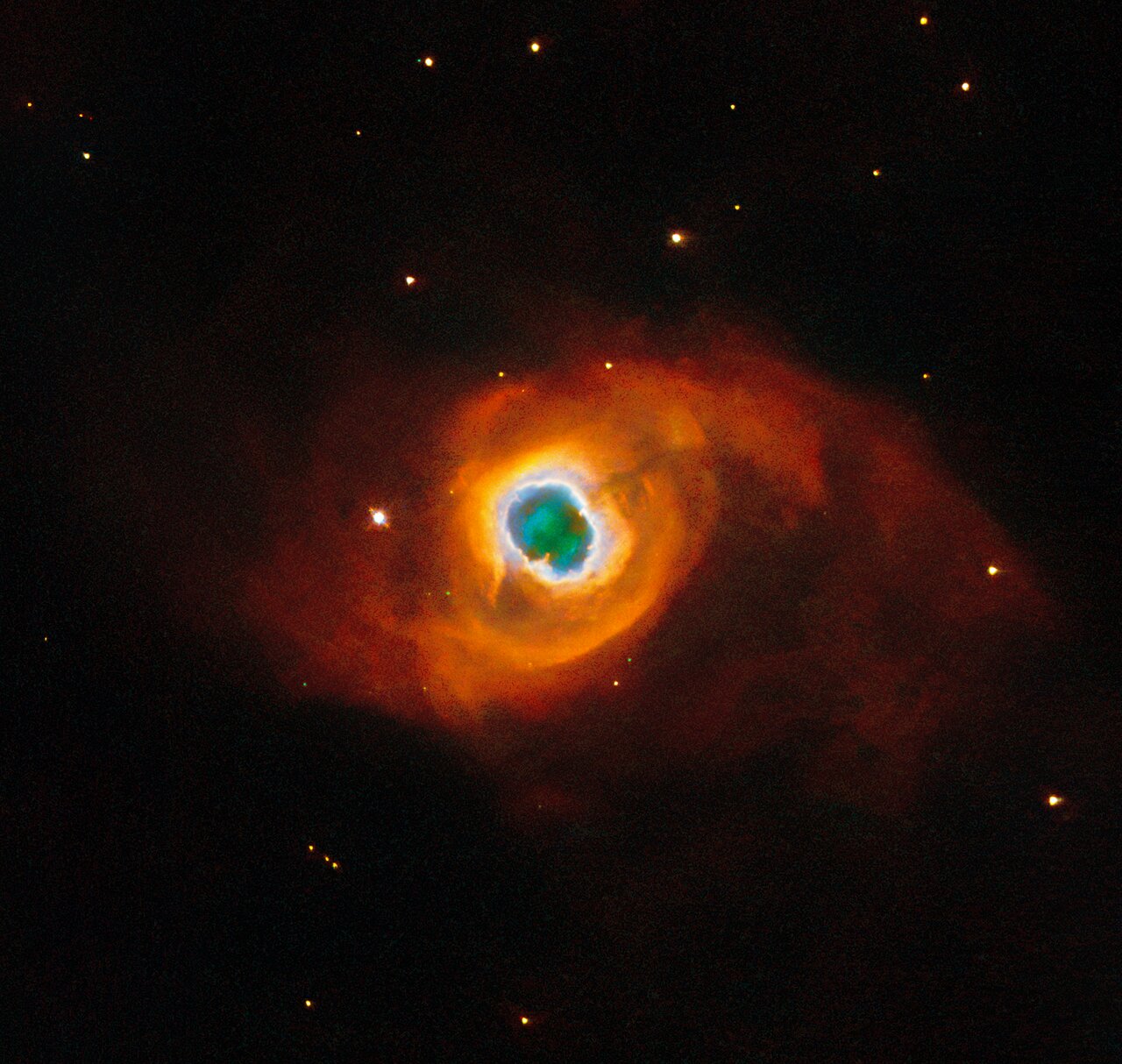Blog
The swirling, paint-like clouds in the darkness of space in this stunning image seem surreal, like a portal to another world opening up before us. In fact, the subject of this ESA/Hubble Picture of the Week is very real. We are seeing vast clouds of ionised atoms and molecules, thrown into space by a dying star. This is a planetary nebula named Kohoutek 4-55, a member of the Milky Way galaxy situated just 4600 light-years away in the constellation Cygnus (the Swan).
Planetary nebulae are the spectacular final display at the end of a giant star’s life. Once a red giant star has exhausted its available fuel and shed its last layers of gas, its compact core will contract further, enabling a final burst of nuclear fusion. The exposed core reaches extremely hot temperatures, radiating very energetic ultraviolet light that energises the enormous clouds of cast-off gas. Molecules in the gas are ionised and glow brightly; here, red and orange indicate nitrogen molecules, green is hydrogen and blue shows oxygen in the nebula. Kohoutek 4-55 has an uncommon, multi-layered form: a bright inner ring is surrounded by a fainter layer of gas, all wrapped in a broad halo of ionised nitrogen. The spectacle is bittersweet, as the brief phase of fusion in the core will end after mere tens of thousands of years, leaving a white dwarf that will never illuminate the clouds around it again.
This image itself is also a swan song, the final work of one of Hubble’s instruments: the Wide Field and Planetary Camera 2 (WFPC2). Installed in 1993 to replace the original Wide Field and Planetary Camera, WFPC2 was responsible for some of Hubble’s most enduring images and fascinating discoveries. It in turn was replaced by the Wide Field Camera 3 in 2009, during Hubble’s final servicing mission. The data for this image were taken a mere ten days before the instrument was removed from the telescope, as a fitting send-off for WFPC2 after 16 years’ work. The latest and most advanced processing techniques have been used to bring the data to life one more time, producing this breathtaking new view of Kohoutek 4-55.
[Image Description: A planetary nebula, a glowing shell of material thrown off by a star. A small central region of greenish clouds is encircled by a glowing, jagged ring, like a hole torn in fabric. A band of silvery-blue clouds outside this is again encircled by a larger, fainter yellow ring of gas. Puffy, smoky clouds of orange and red gas billow out from there into a large oval nebula, fading into the dark background of space.]

Ravi Shankar (born Robindro Shaunkor Chowdhury, sometimes spelled as Rabindra Shankar Chowdhury; 7 April 1920 – 11 December 2012) was an Indian sitarist and composer. A sitar virtuoso, he became the world’s best-known expert of Indian classical music (in Sitar) in the second half of the 20th century, and influenced many musicians in India and throughout the world. Shankar was awarded India’s highest civilian honour, the Bharat Ratna, in 1999. He is also the father of American singer Norah Jones and British-American musician and sitarplayer Anoushka Shankar.
Shankar was born to a Bengali family in India, and spent his youth as a dancer touring India and Europe with the dance group of his brother Uday Shankar. At age 18, he gave up dancing to pursue a career in music, studying the sitar for seven years under court musician Allauddin Khan. After finishing his studies in 1944, Shankar worked as a composer, creating the music for the Apu Trilogy by Satyajit Ray, and was music director of All India Radio, New Delhi, from 1949 to 1956. He was nominated for the Academy Award for Best Original Score for scoring the blockbuster Gandhi (1982).
In 1956, Shankar began to tour Europe and the Americas playing Indian classical musicand increased its popularity there in the 1960s through teaching, performance, and his association with violinist Yehudi Menuhin and Beatles guitarist George Harrison. His influence on Harrison helped popularize the use of Indian instruments in Western pop music in the latter half of the 1960s. Shankar engaged Western music by writing compositions for sitar and orchestra and toured the world in the 1970s and 1980s. From 1986 to 1992, he served as a nominated member of Rajya Sabha, the upper chamber of the Parliament of India. He continued to perform until the end of his life. He was a recipient of numerous prestigious musical accolades, including a Polar Music Prize and four Grammy Awards, including Album of the Year for The Concert for Bangladesh in 1973.
more...Ramón “
Mongo” Santamaría Rodríguez (April 7, 1917 – February 1, 2003) was a Cuban percussionist and bandleader who spent most of his career in the United States. Primarily a conga drummer, Santamaría was a leading figure in the pachanga and boogaloo dance crazes of the 1960s. His biggest hit was his rendition of Herbie Hancock‘s “Watermelon Man“, which was inducted into the Grammy Hall of Fame in 1998. From the 1970s, he recorded mainly salsa and Latin jazz, before retiring in the late 1990s.
Mongo learned to play the congas as an amateur rumba musician in the streets of Havana. He then learned the bongos from Clemente “Chicho” Piquero and toured with various successful bands such as the Lecuona Cuban Boys and Sonora Matancera.In 1950, he moved to New York City, where he became Tito Puente‘s conguero and in 1957 he joined Cal Tjader‘s band. He then formed his own charanga, while at the same time recording some of the first rumba and Santería music albums. By the end of the decade, he had his first pachanga hit, “Para ti”. He then became a pioneer of boogaloo with “Watermelon Man” and later signed record deals with Columbia, Atlantic and Fania. He collaborated with salsa artists and became a member of the Fania All-Stars, often showcasing his conga solos against Ray Barretto. In his later years, Santamaría recorded mostly Latin jazz for Concord Jazz and Chesky Records.
more...Billie Holiday (born Eleanora Fagan; April 7, 1915 – July 17, 1959) was an American jazz and swing music singer. Nicknamed “Lady Day” by her friend and music partner, Lester Young, Holiday made a significant contribution to jazz music and pop singing. Her vocal style, strongly influenced by jazz instrumentalists, inspired a new way of manipulating phrasing and tempo. She was known for her vocal delivery and improvisational skills.
After a turbulent childhood, Holiday began singing in nightclubs in Harlem where she was heard by producer John Hammond, who liked her voice. She signed a recording contract with Brunswick in 1935. Her collaboration with Teddy Wilson produced the hit “What a Little Moonlight Can Do“, which became a jazz standard. Throughout the 1930s and 1940s, Holiday had mainstream success on labels such as Columbia and Decca. By the late 1940s, however, she was beset with legal troubles and drug abuse. After a short prison sentence, she performed a sold-out concert at Carnegie Hall. She was a successful concert performer throughout the 1950s, with two further sold-out shows at Carnegie Hall. Because of personal struggles and an altered voice, her final recordings were met with mixed reaction, but were mild commercial successes. Her final album, Lady in Satin, was released in 1958. Holiday died of heart failure on July 17, 1959, at age 44.
Holiday won four Grammy Awards, all of them posthumously, for Best Historical Album. She was inducted into the Grammy Hall of Fame and the National Rhythm & Blues Hall of Fame. In 2000, she was also inducted into the Rock & Roll Hall of Fame as an early influence; their website states that “Billie Holiday changed jazz forever”. She was named one of the 50 Great Voices by NPR and was ranked fourth on the Rolling Stonelist of “200 Greatest Singers of All Time” (2023). Several films about her life have been released, most recently The United States vs. Billie Holiday (2021).
more...Amadou Bagayoko of music duo Amadou & Mariam dies aged 70
Amadou Bagayoko (guitar and vocals) (24 October 1954 – 4 April 2025)
Malian singer and guitarist, who sold millions of albums with his wife, Mariam Doumbia, had been ill for a while, say family.
The guitarist and singer Amadou Bagayoko of the Malian music duo Amadou & Mariam has died aged 70 after an illness, his family said, paying tribute to the Grammy-nominated blind musician.
Amadou and his wife, Mariam Doumbia, formed a group whose blend of traditional Malian music with rock guitars and western blues sold millions of albums across the world.
Among other achievements the couple, who met at the institute for the young blind in the Malian capital, Bamako, composed the official song for the 2006 football World Cup in Germany and played at the closing ceremony concert for the 2024 Olympic Games in Paris.
“He had been ill for a while,” Amadou’s son-in-law Youssouf Fadiga told Agence-France Presse.
Ram Dass (born Richard Alpert; April 6, 1931 – December 22, 2019), also known as Baba Ram Dass, was an American spiritual teacher, guru of modern yoga, psychologist, and writer. His best-selling 1971 book Be Here Now, which has been described by multiple reviewers as “seminal”, helped popularize Eastern spirituality and yoga in the West. He authored or co-authored twelve more books on spirituality over the next four decades, including Grist for the Mill (1977), How Can I Help? (1985), and Polishing the Mirror (2013).
Ram Dass was personally and professionally associated with Timothy Leary at Harvard University in the early 1960s. Then known as Richard Alpert, he conducted research with Leary on the therapeutic effects of psychedelic drugs. In addition, Alpert assisted Harvard Divinity School graduate student Walter Pahnke in his 1962 “Good Friday Experiment” with theology students, the first controlled, double-blind study of drugs and the mystical experience. While not illegal at the time, their research was controversial and led to Leary’s and Alpert’s dismissal from Harvard in 1963.
In 1967, Alpert traveled to India and became a disciple of Hindu guru Neem Karoli Baba, who gave him the name Ram Dass, meaning “Servant of Ram,” but usually rendered simply as “Servant of God” for Western audiences. In the following years, he co-founded the charitable organizations Seva Foundation and Hanuman Foundation. From the 1970s to the 1990s, he traveled extensively, giving talks and retreats and holding fundraisers for charitable causes. In 1997, he had a stroke, which left him with paralysis and expressive aphasia. He eventually grew to interpret this event as an act of grace, learning to speak again and continuing to teach and write books. After becoming seriously ill during a trip to India in 2004, he gave up traveling and moved to Maui, Hawaii, where he hosted annual retreats with other spiritual teachers until his death in 2019.
more...
Happy Birthday Carson
My oldest grandson turns 18 yrs old today Wow!
Carson lives in Pittsburgh.
Love you Carson

Sunday April 6th 2025 7pm. Performing tonight with Ahmed Yusuf and Ahmed Mohamed and several Somali singers. Pictured in my rehearsal studio.
“Meet You at the Crossroads.” The concert is co-produced by the University of St. Thomas’ Jay Phillips Center for Interreligious Studies and the Cultural Fluency Initiative. In the Schoenecker Science Center Performance Hall.
In a Minneapolis rehearsal room, a group of Somali musicians gathers in a circle, playing music rooted in the cafés of Mogadishu. The sound is emotional, rhythmic and steeped in memory. It’s called “Somali blues.”
“The lyrics are just showing you what it means,” says Ahmed Ismail Yusuf, the group’s leader. The style is similar to what you might have heard in Somalia before the civil war.
“It is this lugubrious, lamentation [of] love not returned.”
Yusuf and the small outfit — called Araa — are rehearsing for an upcoming concert, “Meet You at the Crossroads.” The concert is co-produced by the University of St. Thomas’ Jay Phillips Center for Interreligious Studies and the Cultural Fluency Initiative.
“This is really about the life of the city. There are more cultural groups in the Twin Cities than ever,” said David Jordan Harris, who works with the Jay Phillips Center and curated the concert. “Yet, do we know each other? How do we learn about each other? And you know, no better method than our musical traditions.”
“Meet You at the Crossroads” will bring together Somali blues and songs inspired by Black gospel music. The idea came from a previous experiment Harris developed with Beck Lee, who runs the Cultural Fluency Initiative.
“We did sort of a proof of concept concert salon a little while ago where we where we juxtaposed Sephardic music and Somali music,” Lee said. “It was just interesting to be able to experience those two musical cultures and juxtaposition and talk about it.”
This time, Lee and Harris invited Yusuf to lead the Somali music, and JD Steele to bring the Black soul repertoire.

It’s galaxy season, and two of my favorites are M81 (upper left) and M82 (lower right), a pair of galaxies located in the constellation, Ursa Major. M81 (Bode’s Galaxy) is a face-on spiral galaxy, about half the diameter of our Milky Way, and lies approximately 11.8 million light-years away, while M82 (The Cigar Galaxy) is an irregular edge-on galaxy at roughly the same distance. These galaxies have a gravitational lock on each other and interact, affecting the shape and composition of one another. This image was shot last night, over about 6 hours, from our front yard with the telescope in the shadow of the nearly full moon.

Beverly “Guitar” Watkins (April 6, 1939 – October 1, 2019 Atlanta) was an American blues guitarist. Sandra Pointer-Jones wrote, “Beverly Watkins is a pyrotechnic guitar maven whose searing, ballistic attacks on the guitar have become allegorical tales within the blues community.” George Varga, reviewing her debut CD, observed that Watkins “sings and plays with enough poise and verve to make musicians half her age or younger consider alternative means of employment.”
more...Randolph Edward “Randy” Weston (April 6, 1926 – September 1, 2018 NY) was an American jazz pianist and composer whose creativity was inspired by his ancestral African connection.
Weston’s piano style owed much to Duke Ellington and Thelonious Monk, whom he cited in a 2018 video as among pianists he counted as influences, as well as Count Basie, Nat King Cole and Earl Hines. Beginning in the 1950s, Weston worked often with trombonist and arranger Melba Liston.
Described as “America’s African Musical Ambassador”, Weston once said: “What I do I do because it’s about teaching and informing everyone about our most natural cultural phenomenon. It’s really about Africa and her music.”
more...John Paul Pizzarelli Jr. (born April 6, 1960) is an American jazz guitarist and vocalist. He has recorded over twenty solo albums and has appeared on more than forty albums by other recording artists, including Paul McCartney, James Taylor, Rosemary Clooney; his father, jazz guitarist Bucky Pizzarelli; and his wife, singer Jessica Molaskey.
more...Charlie Rouse (April 6, 1924 – November 30, 1988 D.C.) was an American hard bop tenor saxophonist and flautist. His career is marked by his collaboration with Thelonious Monk, which lasted for more than ten years.
more...Arthur S. Taylor Jr. (April 6, 1929 – February 6, 1995 NY) was an American jazz drummer, who “helped define the sound of modern jazz drumming”. As a teenager, Taylor first decided that he wanted to become a musician after hearing Sid Catlett play at a jam session at the current site of the Lincoln Center. He joined a local Harlem band that featured Sonny Rollins, Jackie McLean and Kenny Drew. After playing in the bands of Howard McGhee (1948), Coleman Hawkins (1950–51), Buddy DeFranco (1952), Bud Powell (1953–58; 1961; 1964), George Wallington and Art Farmer (1954), Wallington again (1954–55), Gigi Gryce and Donald Byrd (1956), he formed his own group, Taylor’s Wailers. Between 1957 and 1963, he toured with Donald Byrd, recorded with Miles Davis, Gene Ammons and John Coltrane, and performed with Thelonious Monk; Taylor also was a member of the original Kenny Dorham Quartet of 1957.
more...
More Posts
- Ed Cherry
- Guitar Gabriel
- Harmonica Frank
- World Music with Toumani & Sidiki Diabate
- Daily Roots with Patrick Andy
- Carlos Nakai
- Indigenous Peoples Day 2021
- The Cosmoz with NGC 4666
- Lester Bowie
- Billy Higgins
- Art Blakey
- World Music with Tündra
- Daily Roots with Horace Andy
- The Cosmos with M 27
- Cyril Neville
- John Prine
- Junior Mance
- Thelonious Monk
- World Music with the Madalitso Band
- Daily Roots with Barry Brown

